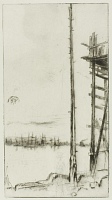Etchings Institutions search term: caxton club
Shipbuilder's Yard, Liverpool | ||
| Number: | 142 | |
| Date: | 1875 | |
| Medium: | drypoint | |
| Size: | 279 x 152 mm | |
| Signed: | butterfly at left (1-3); redrawn (3-final) | |
| Inscribed: | no | |
| Set/Publication: | 'Cancelled Plates', 1879 | |
| No. of States: | 4 | |
| Known impressions: | 24 | |
| Catalogues: | K.146; M.144; W.121 | |
| Impressions taken from this plate (24) | ||
PUBLICATION
EXHIBITIONS
11: 'Exhibition of Etchings', Glasgow Herald, 1 June 1881.
 ). 12 Another was shown by H. Wunderlich & Co., New York in 1898, and was bought by Charles Lang Freer (1856-1919) (
). 12 Another was shown by H. Wunderlich & Co., New York in 1898, and was bought by Charles Lang Freer (1856-1919) ( ). 13
). 13
Impressions were also exhibited after Whistler's death in the principal Memorial Exhibitions. Two states were shown at the Grolier Club in New York in 1904 and another at the Whistler Memorial Exhibition in London in 1905. 14
12: New York 1881 (cat. no. 140); Chicago 1900 (cat. no. 109). See REFERENCES : EXHIBITIONS.
13: New York 1898 (cat. no. 104)
14: New York 1904a (cat. nos. 125, 125b); London Mem. 1905 (cat. no. 121).
SALES & COLLECTORS
 ).
).15: [March/April 1875], GUW #07573.
 ) and another to Charles Augustus Howell (1840?-1890) in 1877 for £6.6.0 each. 16 The former was sold later by Wunderlich's to Clarence Buckingham (1855-1913), and passed with his collection to the Art Institute of Chicago.
) and another to Charles Augustus Howell (1840?-1890) in 1877 for £6.6.0 each. 16 The former was sold later by Wunderlich's to Clarence Buckingham (1855-1913), and passed with his collection to the Art Institute of Chicago. ). Margaret Selkirk Watson Parker (1867-1936) bequeathed one to the University of Michigan Art Museum (
). Margaret Selkirk Watson Parker (1867-1936) bequeathed one to the University of Michigan Art Museum ( ). Henry Harper Benedict (1844-1935), Harris G. Whittemore (d. ca 1937) and William Sloane-Kinney (1883 - 1952) were among the distinguished owners of another impression (
). Henry Harper Benedict (1844-1935), Harris G. Whittemore (d. ca 1937) and William Sloane-Kinney (1883 - 1952) were among the distinguished owners of another impression ( ).
).
